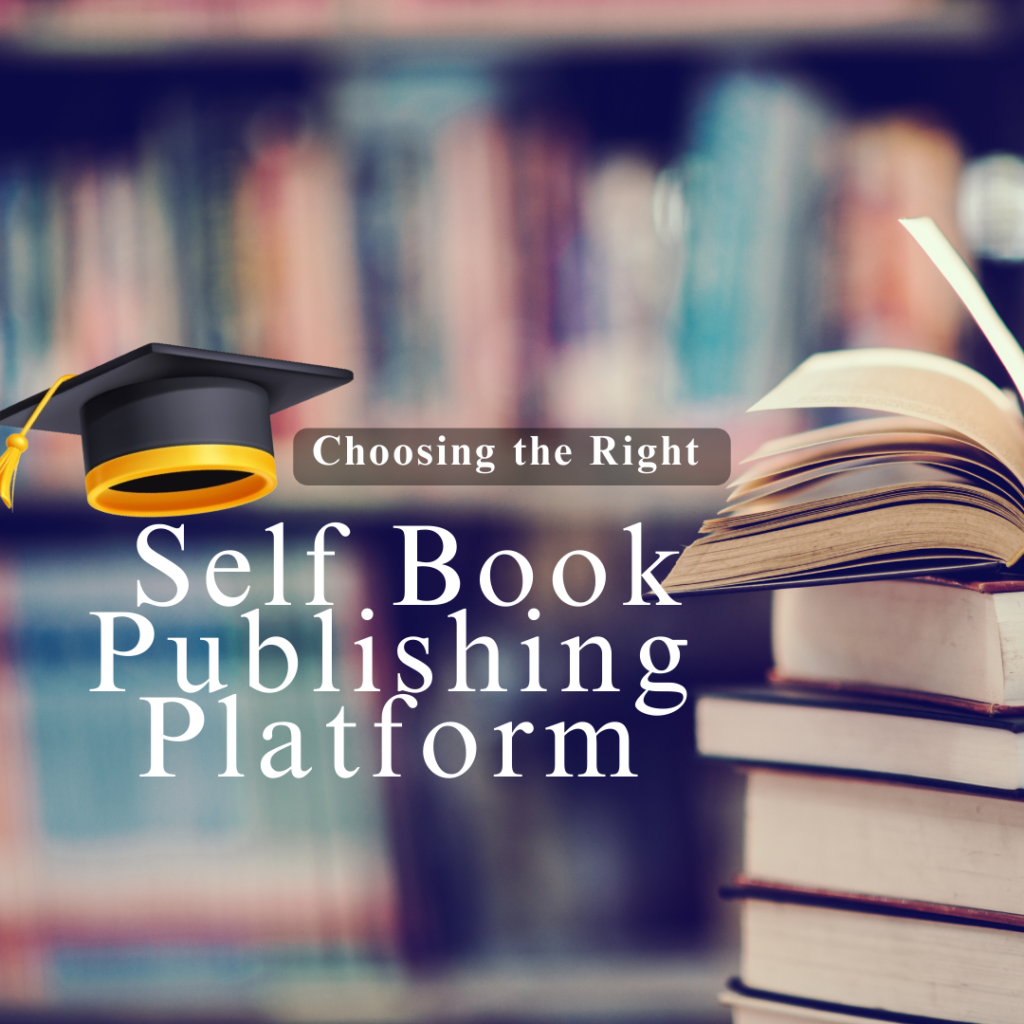Introduction
Authors today have unprecedented opportunities to bring their thoughts and stories to life through self book publishing in the ever-changing landscape of contemporary publishing. Unlike traditional routes, self book publishing empowers writers to reach a global audience, maintain complete creative control over their work, and earn royalties directly from sales. This empowering method has revolutionized the publishing industry, allowing authors to bypass traditional gatekeepers and connect directly with readers worldwide.
Choosing the best self book publishing platform is crucial to this process, as it can significantly impact an author’s happiness and success. The right platform not only facilitates the publishing process but also enhances visibility, distribution, and ultimately, the potential for financial gain. Authors can tailor their publishing experience to match their unique goals and preferences, whether they prioritize wide distribution, maximum royalties, or additional author services like editing and marketing support.
Furthermore, self book publishing platforms offer diverse opportunities for authors to experiment with different formats such as ebooks, print-on-demand, and audiobooks. This flexibility allows authors to cater to the preferences of various reader demographics and adapt to evolving market trends.
☆ Understanding Self Book Publishing

Self book publishing, often referred to as indie publishing, represents a paradigm shift in the world of literature. It liberates authors from the traditional constraints of publishing houses, offering unprecedented autonomy and control over every aspect of their books. This freedom extends not only to the content itself but also to the design choices, marketing strategies, and distribution channels employed. Authors are no longer beholden to the preferences and timelines of traditional publishers, allowing them to cater directly to their readers’ interests and preferences.
One of the most significant advantages of self book publishing is the retention of ownership. Unlike traditional publishing routes, where rights and control over the work often transfer to the publisher, self-publishing authors maintain full ownership of their intellectual property. This ownership extends beyond the initial publication to encompass any future adaptations, translations, or licensing agreements, ensuring that authors retain control over the long-term exploitation of their creative work.
Financially, self book publishing offers authors the potential for higher royalties per sale compared to traditional publishing arrangements. While traditional publishers typically offer authors royalties ranging from 6% to 25% of net sales, self-publishing platforms often provide royalty rates of 35% to 70% of the list price, depending on the distribution channel and pricing strategy chosen. This financial incentive can be particularly appealing to authors seeking to maximize their earnings from book sales.
🔑 Key Considerations for Platform Selection

When selecting the optimal self book publishing platform, authors should delve into several critical factors to ensure their publishing journey is both smooth and successful.
- Cost Structure: Evaluate setup fees, commission rates per sale, and any hidden costs.
- Distribution Channels: Assess which platforms offer broad distribution across online retailers, physical stores, and libraries.
- Author Services: Look for additional services such as editing, cover design, and marketing assistance.
- Royalty Rates: Compare royalty percentages offered by different platforms.
- Ease of Use: Consider the platform’s user interface, tools for formatting, and publishing process simplicity
☆ Your Path to Authorship Starts Now!

Embarking on the journey of becoming an author through self book publishing opens doors to endless possibilities. This empowering method allows you to express your unique voice, share your stories, and connect directly with readers worldwide. Whether you’re writing fiction, non-fiction, poetry, or memoirs, self book publishing enables you to take control of your creative destiny and bring your vision to life.
☆ The Ideal Self Book Publishing Platform Hinges on Your Unique Goals

Choosing the right self book publishing platform is a pivotal decision that should align closely with your individual aspirations as an author. Every platform offers distinct advantages tailored to different priorities, whether you prioritize wide distribution, maximizing royalties, or comprehensive author support services. Before selecting a platform, take the time to define your goals clearly:
- Wide Distribution: If reaching a broad audience across multiple channels is crucial to you, prioritize platforms that have extensive partnerships with online retailers, physical bookstores, and libraries.
- Maximum Royalties: If maximizing your earnings per book sale is a top priority, compare royalty rates offered by different platforms. Look for platforms that offer competitive royalty percentages and transparent fee structures.
- Comprehensive Author Support Services: For authors seeking additional support with editing, cover design, marketing, and promotion, explore platforms that provide comprehensive author services. Consider the quality and cost-effectiveness of these services to ensure they align with your needs.
By defining your priorities upfront, you can narrow down your choices and select a self book publishing platform that best supports your specific goals and enhances your overall publishing experience. Remember, there’s no one-size-fits-all solution—your ideal platform is the one that empowers you to achieve your unique vision as an author.
☆ Research Each Platform Thoroughly
Choosing the right self book publishing platform requires diligent research and comparison. Here’s how to approach it:
- Read Reviews: Start by reading reviews from other authors who have used the platforms you’re considering. Pay attention to feedback on customer service, ease of use, royalty payments, and overall satisfaction.
- Explore Sample Books: Look for sample books published through each platform. This allows you to assess the quality of formatting, cover design, and overall presentation. It’s also helpful to see how well books from each platform are received by readers.
- Seek Advice: Connect with other self-published authors for insights and recommendations. They can provide valuable firsthand experiences and recommendations based on their own publishing journeys.
- Compare Features: Evaluate each platform’s features and services, such as distribution options, marketing tools, royalties, and additional author services like editing and design. Consider which features are essential to achieving your publishing goals.
- Consider Long-Term Support: Assess the platform’s commitment to ongoing support, updates, and responsiveness to author needs. A platform that prioritizes continuous improvement can offer a more satisfying long-term publishing experience.
- Check Terms and Conditions: Carefully review the terms and conditions of each platform, including contractual agreements, rights management policies, and any exclusivity requirements. Ensure these align with your publishing goals and preferences.
Taking the time to research and compare self book publishing platforms ensures that you make an informed decision that aligns with your goals and sets the stage for a successful publishing journey. Remember, the platform you choose should not only meet your immediate needs but also support your long-term aspirations as an author.
☆ Traditional Publishing vs. Self-Publishing: Weighing Your Options

When deciding between Traditional Publishing and Self-Publishing, it’s essential to weigh their distinct characteristics and how they align with your goals as an author:
Traditional Publishing:
Pros:
- No Cost: Traditional publishers cover upfront costs and earn through book sales.
- Credibility: Adds prestige with support from established publishing houses.
- Industry Knowledge: Publishers offer expertise in editing, design, and marketing.
Cons:
- Loss of Control: Authors have limited say in design, title, and other aspects.
- Longer Timelines: The process from submission to publication can be lengthy.
- Lower Royalties: Authors receive a percentage of sales, typically lower than self-publishing.
Self-Publishing:
Pros:
- Creative Freedom: Authors retain full control over their work’s content and design.
- Higher Royalties: Authors earn more per sale compared to traditional publishing.
- Flexibility: Faster timelines from completion to publication and greater independence.
Cons:
- Marketing Responsibility: Authors are responsible for promoting their books.
- Quality Perception: Some readers may perceive self-published works as lower in quality, though this stigma is diminishing.
In making your decision, consider how much creative control you desire, your timeline for publication, and your financial expectations. Traditional publishing offers credibility and expert support but at the cost of relinquishing control and potentially lower royalties. Self-publishing provides autonomy and higher earnings but requires authors to manage marketing and overcome any lingering perceptions of quality.
Ultimately, the choice between Traditional Publishing and Self-Publishing hinges on your priorities as an author and your vision for your book’s success in the competitive marketplace.
☆ The Future of Self-Publishing: Emerging Trends and Opportunities

As self-publishing continues to thrive and adapt to the digital age, several emerging trends are shaping its future:
- Increased Audiobook Production: The demand for audiobooks is on the rise, driven by busy lifestyles and the convenience of audio consumption. Self-published authors are increasingly investing in audiobook production to reach a broader audience and cater to diverse reader preferences.
- Personalized Marketing Strategies: With access to detailed reader data and analytics, self-published authors can personalize their marketing efforts more effectively. This includes targeted advertising, email campaigns tailored to reader interests, and leveraging reader feedback to refine promotional tactics.
- Enhanced Reader Engagement: Online platforms and social media play a pivotal role in enhancing reader engagement. Authors can interact directly with readers through platforms like Goodreads, Facebook groups, and author websites. Engaging content such as behind-the-scenes updates, interactive polls, and virtual book signings foster a loyal and engaged readership.
- Technological Advancements: Advances in technology continue to democratize publishing tools, making it easier for authors to produce high-quality books independently. From sophisticated self-publishing platforms to user-friendly design software and digital distribution channels, technology empowers authors to compete on equal footing with traditional publishers.
- Global Reach: Self-publishing facilitates global reach, allowing authors to distribute their books internationally through digital platforms like Amazon Kindle Direct Publishing (KDP) and IngramSpark. Localization options for ebooks and print-on-demand services enable authors to connect with readers worldwide in their preferred language and format.
- Collaborative Publishing Models: Collaborative platforms and author collectives are emerging, enabling self-published authors to pool resources, share expertise, and cross-promote each other’s work. This collaborative approach fosters a supportive community and expands promotional reach, benefiting all involved authors.
☆ Conclusion: Embark on Your Self-Publishing Journey with Confidence
Self-publishing is evolving with technological advances and changing reader preferences. Authors can leverage trends like increased audiobook production, personalized marketing strategies, and enhanced reader engagement through online platforms. By embracing these opportunities and innovations, authors can navigate the dynamic landscape of self-publishing to reach global audiences, retain creative control, and maximize their success in the digital era of publishing.

